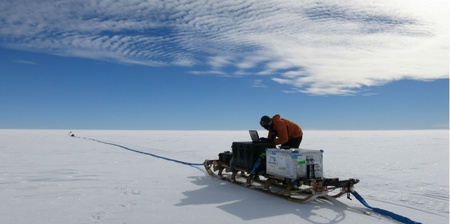Scientists from the University of Aberdeen have helped carry out a detailed survey of the landscape beneath thick Antarctic ice that researchers say will be a valuable resource in understanding how ice draining into the ocean contributes to global sea level rise.
Radar surveys of the land beneath Pine Island Glacier, obtained by snowmobile, have revealed a surprisingly diverse, mountainous landscape under the ice.
The findings are significant as Pine Island Glacier is the fastest melting glacier in Antarctica and currently accounts for up to 10 per cent of global sea level rise.
Ice melting into the ocean in the region is expected to increase as the climate warms and the West Antarctic ice sheet continues to thin.
The survey of the glacier, the most detailed to date, was carried out during the Antarctic summer of 2013 - 2014 by a team working round the clock. Snow vehicles equipped with radar sensors surveyed about 1500 sq km of ice, taking readings every few hundred metres.
The findings represent significant progress in the data available to inform forecasts of ice loss. Previous computer models used less comprehensive data from aerial radar surveys, which did not account for a range of ice bed shapes and the effects these could have on glacier friction.
The study shows that the diverse nature of the terrain beneath the glacier is the biggest factor affecting the flow of the ice across the landscape.
Scientists will incorporate the new findings into computer models used to project the glacier’s future.
The study, published in Nature Communications, was led by the University of Edinburgh in collaboration with the University of Aberdeen, the British Antarctic Survey, the Universities of Swansea and Exeter, and partners in the US and New Zealand. It was funded under the Natural Environment Research Council’s iSTAR programme.
Dr Matteo Spagnolo, from the University of Aberdeen’s School of Geosciences, was among those who assisted with the study.
He said: “This study represents one of the rare examples where we have been able to image the ice-bed interface of ice streams - the arteries of ice sheets - at high resolution with radar penetrating through ice that is more than a kilometre thick.
“It reveals a fascinating landscape of streamlined landforms, considerably more variable than anticipated.
“These bedforms, which have been the focus of my research for many years, represent a considerable resisting element to, and therefore a crucial control on, the flow of ice. Models of ice stream flow should attempt to incorporate the variable topography we have shown to exist under the ice to improve their reliability.”
Dr Robert Bingham, formerly of the University of Aberdeen and now of the University of Edinburgh’s School of GeoSciences, led the research.
He said: “Detailed understanding of this diverse landscape, and how that will impact on ice melt from one of Antarctica’s most important glaciers, will give us valuable clues as to how warming in this region will impact on global sea level.”


